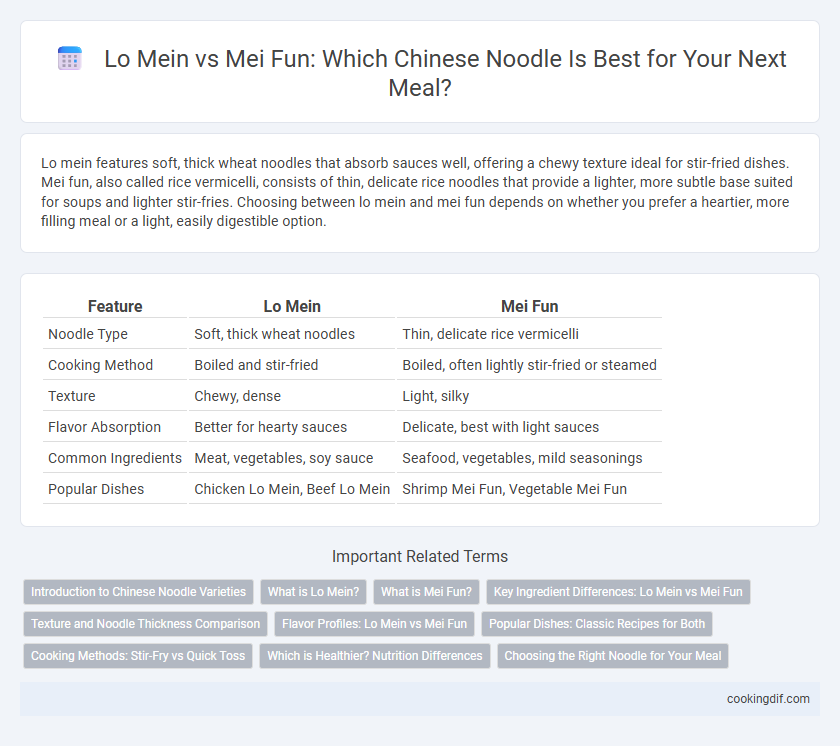Lo mein features soft, thick wheat noodles that absorb sauces well, offering a chewy texture ideal for stir-fried dishes. Mei fun, also called rice vermicelli, consists of thin, delicate rice noodles that provide a lighter, more subtle base suited for soups and lighter stir-fries. Choosing between lo mein and mei fun depends on whether you prefer a heartier, more filling meal or a light, easily digestible option.
Table of Comparison
| Feature | Lo Mein | Mei Fun |
|---|---|---|
| Noodle Type | Soft, thick wheat noodles | Thin, delicate rice vermicelli |
| Cooking Method | Boiled and stir-fried | Boiled, often lightly stir-fried or steamed |
| Texture | Chewy, dense | Light, silky |
| Flavor Absorption | Better for hearty sauces | Delicate, best with light sauces |
| Common Ingredients | Meat, vegetables, soy sauce | Seafood, vegetables, mild seasonings |
| Popular Dishes | Chicken Lo Mein, Beef Lo Mein | Shrimp Mei Fun, Vegetable Mei Fun |
Introduction to Chinese Noodle Varieties
Lo mein features thick, chewy wheat noodles commonly stir-fried with vegetables, meats, and a savory sauce, delivering a hearty texture and rich flavor. Mei fun, also known as rice vermicelli, consists of thin, delicate rice noodles typically used in lighter dishes or soups, offering a subtle taste and smooth mouthfeel. Both noodle varieties showcase the diversity of Chinese cuisine, emphasizing regional ingredients and cooking techniques.
What is Lo Mein?
Lo Mein is a popular Chinese noodle dish made with boiled egg noodles stir-fried with vegetables, meats, or seafood, coated in a savory soy-based sauce. The noodles used in Lo Mein are thicker and chewier compared to Mei fun, which uses thin rice vermicelli noodles. Lo Mein offers a hearty and satisfying texture, making it a staple choice for those seeking a rich and flavorful noodle meal.
What is Mei Fun?
Mei fun, also spelled mei fen or rice vermicelli, is a thin, delicate rice noodle used in Chinese cuisine, distinct from the thicker wheat-based lo mein. These translucent noodles are prized for their light texture and ability to absorb rich sauces, making them ideal for stir-fries, soups, and cold dishes. Mei fun offers a gluten-free alternative and is especially popular in Cantonese and Southeast Asian cooking for its subtle flavor and versatility.
Key Ingredient Differences: Lo Mein vs Mei Fun
Lo Mein uses thick wheat noodles made from egg and wheat flour, providing a chewy texture that absorbs sauces well, while Mei Fun features thin rice vermicelli noodles crafted from rice flour, resulting in a light and delicate bite. The wheat-based lo mein noodles have a higher gluten content, making them more elastic and ideal for stir-frying with savory ingredients like soy sauce and vegetables. Mei Fun's rice noodles are naturally gluten-free, often paired with lighter broths or stir-fries, absorbing flavors subtly without becoming overly soft.
Texture and Noodle Thickness Comparison
Lo mein noodles are thicker and chewier, providing a heartier texture that holds up well to stir-frying and rich sauces. Mei fun, also known as rice vermicelli, is much thinner and softer, delivering a delicate and light mouthfeel ideal for soups and lighter dishes. The contrasting thickness and texture between lo mein and mei fun noodles define their distinct culinary uses and flavor absorption.
Flavor Profiles: Lo Mein vs Mei Fun
Lo mein offers a rich, savory flavor profile with thick, chewy wheat noodles that absorb soy-based sauces, creating a hearty and satisfying taste. Mei fun, made from thin rice vermicelli noodles, delivers a lighter, more delicate flavor that pairs well with subtle seasonings and fresh vegetables. The contrasting textures and sauce absorption between lo mein and mei fun distinctly influence their flavor experiences in Chinese cuisine.
Popular Dishes: Classic Recipes for Both
Lo mein features thick, chewy wheat noodles tossed in savory soy-based sauces with vegetables and meats like chicken or beef, creating a hearty, flavorful dish. Mei fun, or rice vermicelli, offers thin, delicate rice noodles often stir-fried with light seasonings, seafood, or mixed vegetables, delivering a subtle, aromatic taste. Classic lo mein recipes include beef and vegetable lo mein, while mei fun is popularly prepared as Singapore mei fun with curry spices or seafood mei fun stir-fry.
Cooking Methods: Stir-Fry vs Quick Toss
Lo mein, known for its soft, chewy texture, is typically stir-fried with vegetables and protein, allowing the sauce to thoroughly coat the noodles. Mei fun, also called rice vermicelli, is quickly tossed or lightly stir-fried, preserving its delicate, thin strands and subtle flavor. The cooking method significantly affects texture and flavor absorption, making lo mein heartier and mei fun lighter and more delicate in Chinese noodle dishes.
Which is Healthier? Nutrition Differences
Lo mein and mei fun differ significantly in nutrition, with lo mein made from thicker wheat noodles containing more calories and carbohydrates compared to the thinner rice-based mei fun. Mei fun typically has fewer calories and lower glycemic index, making it a healthier option for those monitoring their weight and blood sugar levels. Both noodles provide moderate protein and fiber, but the choice depends on dietary preferences and specific nutritional goals.
Choosing the Right Noodle for Your Meal
Lo mein features thick, chewy wheat noodles that absorb rich sauces, perfect for stir-fries with robust flavors and hearty ingredients. Mei fun, also known as rice vermicelli, offers thin, delicate rice-based noodles ideal for light, subtle dishes or soups that highlight fresh vegetables and seafood. Selecting between lo mein and mei fun hinges on balancing noodle texture with the dish's flavor profile and cooking method to enhance the overall dining experience.
Lo mein vs Mei fun for Chinese noodle choice Infographic

 cookingdif.com
cookingdif.com